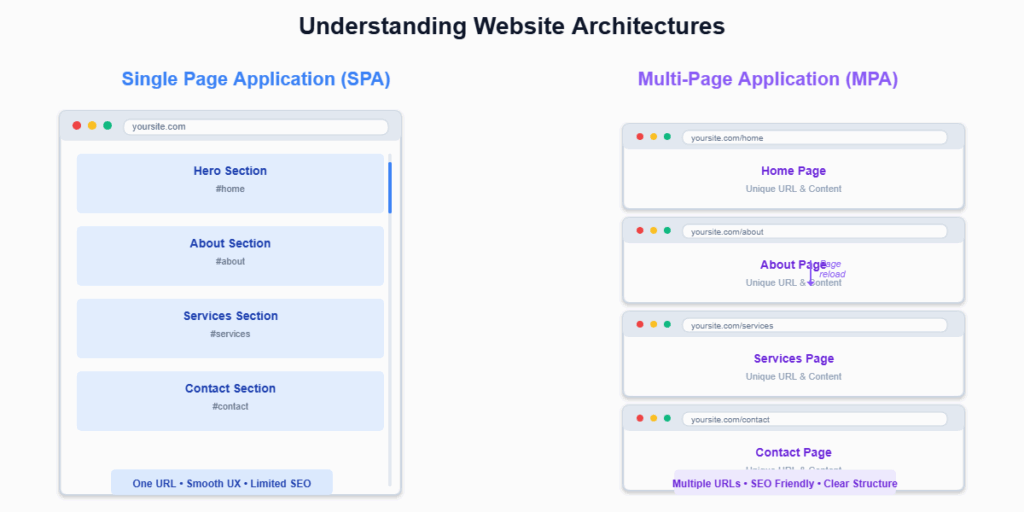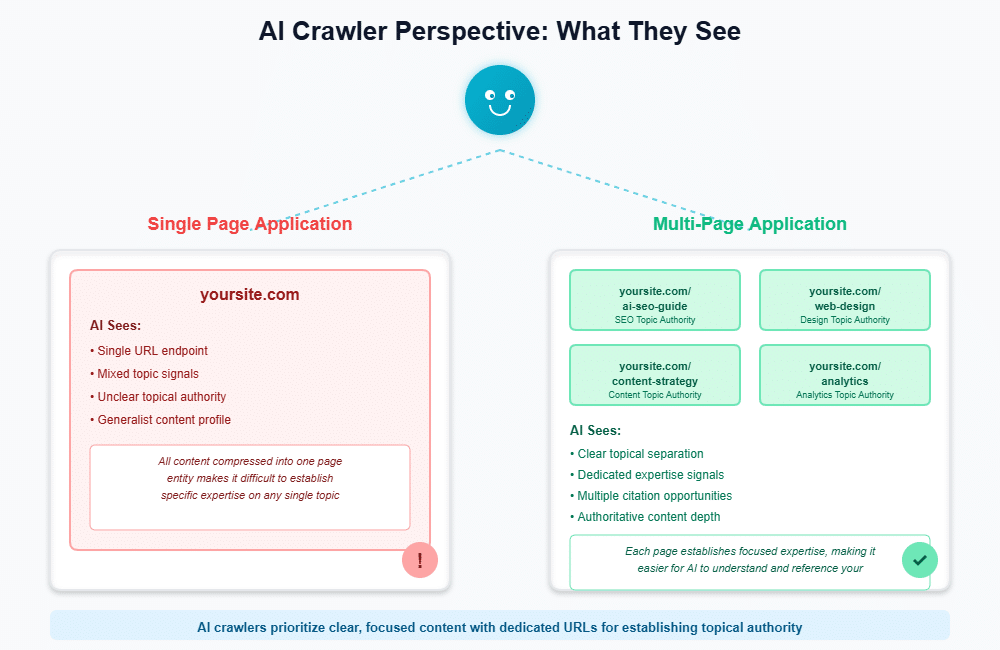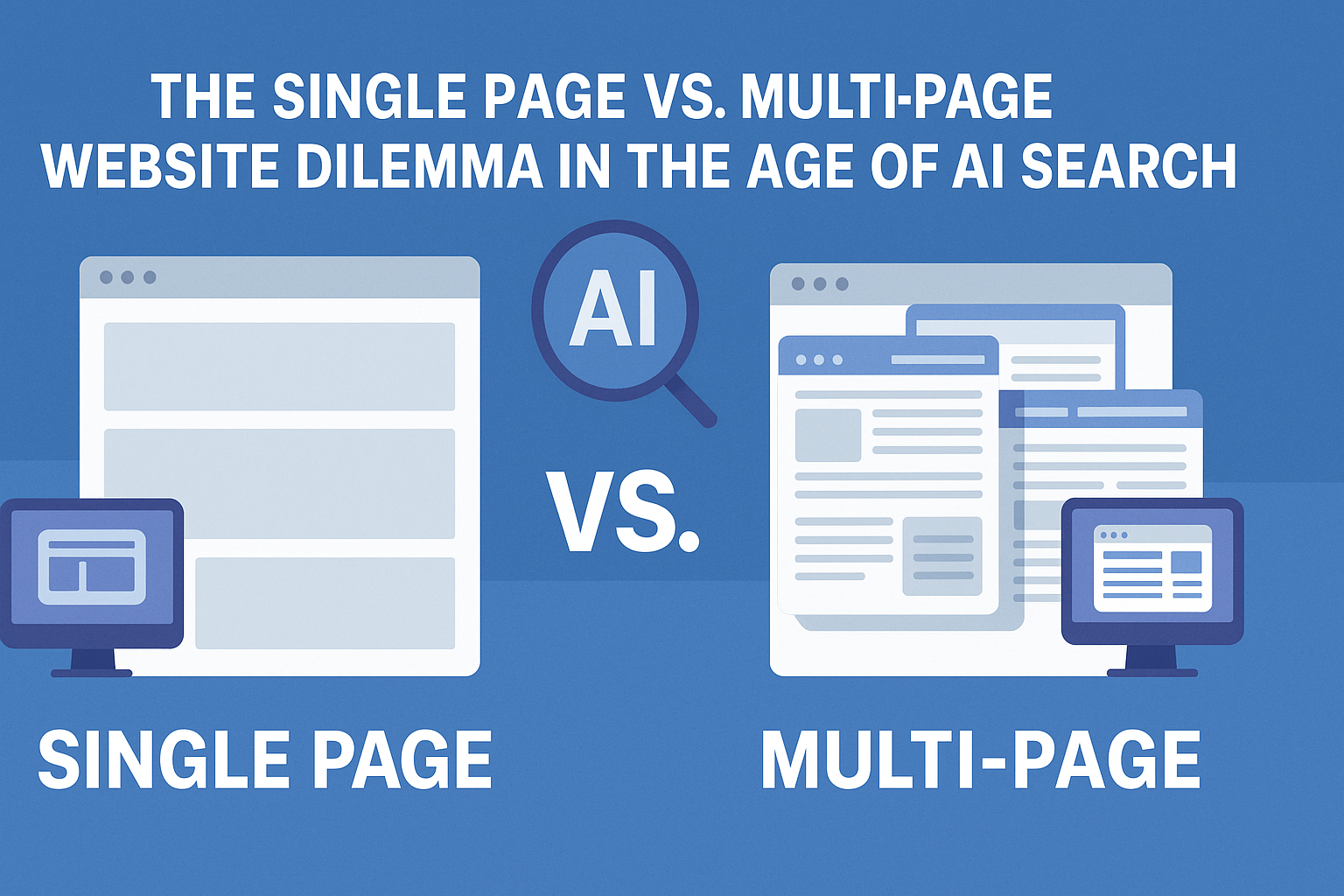As tools like DeepSeek and Perplexity change how we find information, does your website’s structure still matter? Here’s how to choose and optimize for both UX and discoverability.
Introduction: The New Search Landscape
The way we search for information has fundamentally changed. Gone are the days when Google’s ten blue links were our primary gateway to knowledge. Today, AI-powered answer engines like Perplexity, DeepSeek, and ChatGPT are revolutionizing information discovery. These tools don’t just catalog and rank web pages—they synthesize information from multiple sources to provide direct, comprehensive answers to our questions.
This paradigm shift forces us to confront a critical question: In an era where AI crawlers are becoming the new gatekeepers of information, does your website’s structure still matter? Is the classic multi-page site still the gold standard, or does the streamlined, narrative experience of a Single Page Application (SPA) now have a competitive advantage?
The answer isn’t simple, and that’s exactly why it matters. The “best” structure depends entirely on your goals, content strategy, and target audience. This article will break down the pros, cons, and best practices for each approach to help you make an informed decision that serves both your users and the AI systems that increasingly determine your content’s reach.
Understanding the Core Architectures
What is a Single-Page Website (SPA)?
A Single Page Application is a website that dynamically rewrites the current page rather than loading entirely new pages from the server. Think of platforms like Netflix, Gmail, or many modern portfolio sites. When you navigate through different sections, you’re not actually jumping between separate web pages—instead, JavaScript is updating the content on the same page in real-time.
Key Characteristics:
- Smooth scrolling navigation between sections
- Anchored navigation that jumps to different parts of the same page
- An “app-like” feel with seamless transitions
- All content typically shares a single URL (though this can be modified with advanced techniques)
What is a Multi-Page Website (MPA)?
The Multi-Page Application represents the traditional website structure that has dominated the web since its inception. It consists of multiple distinct pages, each with unique URLs for different sections and topics. Wikipedia, Amazon, and most corporate websites follow this model.
Key Characteristics:
- Clear information hierarchy with dedicated pages for specific topics
- Unique URLs for each page (e.g., yoursite.com/about, yoursite.com/services)
- Traditional navigation menus that link to separate pages
- Each page loads independently from the server

The Pros and Cons – A Detailed Breakdown
Single-Page Websites (SPAs)
Pros:
Superior User Experience (UX): SPAs excel at creating seamless, fast transitions between sections with no jarring page reloads. This makes them ideal for storytelling and guided narratives where you want to control the user’s journey from start to finish.
Mobile-First Friendly: The smooth scrolling and app-like feel of SPAs often translates beautifully to mobile devices, providing a native app experience that feels natural to touch-based navigation.
Simplified Hosting & Development: Many SPAs require less complex backend infrastructure, making them easier to deploy and maintain, especially for smaller projects or teams with limited technical resources.
High Engagement for Linear Journeys: When your goal is to guide users through a specific sequence of information—such as showcasing a portfolio, launching a product, or presenting a simple service offering—SPAs can be incredibly effective at maintaining engagement.
Cons:
SEO Challenges: Despite improvements in how search engines handle JavaScript, SPAs still face significant SEO hurdles. Since all content exists on a single URL, it’s challenging to rank for a diverse array of keywords. Search engines struggle to understand and index the different sections as distinct, authoritative pieces of content.
Content Limitations: As your content grows, SPAs become increasingly cumbersome and slow to load. They’re poorly suited for sites that need extensive blogs, detailed documentation, or e-commerce catalogs with hundreds of products.
Analytics & Tracking: Traditional web analytics rely on pageviews to measure engagement. With an SPA, it’s much harder to track how users interact with specific sections or identify which content resonates most with your audience.
Accessibility (a11y): Implementing proper accessibility features for screen readers and keyboard navigation can be significantly more complex in SPAs, requiring careful attention to focus management and semantic markup.
Multi-Page Websites (MPAs)
Pros:
SEO Powerhouse: MPAs are the clear winner for organic search performance. Each dedicated page can target specific long-tail keywords and establish topical authority. This structure is particularly advantageous for AI search crawlers, which seek comprehensive, authoritative content on specific subjects. A page dedicated to “sustainable packaging solutions” will always outperform a single section buried in an SPA when AI tools look for expertise on that topic.
Content Organization: For businesses with large volumes of information, MPAs provide the perfect framework for logical categorization. Separate sections for Blog, Services, About, Contact, and Support create clear user pathways and help both humans and crawlers understand your site’s scope.
Clear User Pathways: Users can enter your site at any point without losing context. Whether they arrive via search, social media, or direct links, they immediately understand where they are in your site’s hierarchy and how to navigate to related content.
Flexible Analytics: With unique URLs for each page, you gain granular insights into which specific topics and pages resonate most with your audience, enabling data-driven content and marketing decisions.
Cons:
Potentially Slower Performance: Each navigation requires a server request and page reload, which can feel less seamless than the instant transitions of SPAs, especially on slower connections.
More Complex Maintenance: MPAs typically require more sophisticated content management systems and careful attention to site architecture, navigation design, and internal linking structures.
Risk of Poor Navigation: If your site structure becomes confusing or your navigation unclear, users can easily get lost or frustrated, leading to higher bounce rates and poor user experience.
The AI Search Factor: A New Variable in the Equation
Understanding how AI search engines operate is crucial for making informed structural decisions. Unlike traditional search engines that primarily relied on keywords and backlinks, AI crawlers are sophisticated content analyzers that value comprehensive coverage, clear topical authority, and semantic relevance.

How AI Search Engines Work: These systems act as intelligent content scrapers, seeking to understand not just what your content says, but what expertise it demonstrates. They analyze context, depth of coverage, and the relationships between different pieces of content to determine authority on specific topics.
Implication for SPAs: This presents a significant challenge. When all your content exists under a single URL, AI systems see only one “page” of expertise. It becomes much harder to establish topical authority across multiple subjects. If your SPA covers web design, SEO, and content marketing, an AI crawler might struggle to understand which topics you’re truly authoritative about.
Implication for MPAs: This is where MPAs shine in the AI era. Each dedicated page—such as /blog/ai-seo-best-practices or /services/conversion-rate-optimization—represents a unique entity that AI can crawl, understand, and potentially cite as a specialized source for very specific queries. This structure allows you to “cast a wider net” in the ocean of AI-driven knowledge discovery.
Best Practices: Choosing and Optimizing Your Structure
When to Choose a Single-Page Website:
- Simple, Linear User Journey: Your primary goal is to guide users through a specific sequence of information, such as a product launch landing page or event promotion.
- Limited, Focused Content: Your content centers around a single core offering, story, or theme that benefits from a cohesive, uninterrupted presentation.
- Engagement Over Discovery: Your strategy prioritizes user engagement and conversion over broad organic search traffic. Perhaps you’re driving traffic through paid advertising, social media, or direct referrals.
Examples: Creative portfolios, event websites, product launch pages, simple promotional sites, or “about us” microsites.
When to Choose a Multi-Page Website:
- Extensive, Diverse Content: You have substantial content covering multiple topics, services, or product categories that benefit from dedicated, deep-dive pages.
- Search-Dependent Strategy: Your business model relies heavily on organic search traffic and attracting visitors for diverse, specific queries.
- Complex Information Architecture: You need specialized sections like blogs, knowledge bases, e-commerce catalogs, customer support portals, or resource libraries.
- AI Reference Potential: You want to position yourself as an authoritative source that AI tools will reference when answering specific questions in your domain.
Examples: E-commerce sites, SaaS companies, news outlets, educational platforms, consultancy websites, or any business with a content marketing strategy.
Hybrid Approach: The Best of Both Worlds?
Consider adopting a hybrid strategy that leverages the strengths of both approaches. Use a multi-page structure for your overall site architecture while employing single-page principles within specific sections.
Example: Your main website might have separate pages for Home, About, Blog, and Contact, but your Services page could be a beautifully crafted, smooth-scrolling SPA that tells the story of your offerings in a linear, engaging way.
Essential Best Practices for Both:
For SPAs:
Implement SEO Carefully: Use modern frameworks like Next.js (React) or Nuxt.js (Vue) that support Server-Side Rendering (SSR) or Static Site Generation (SSG). These technologies make your content easily crawlable by both traditional search engines and AI systems.
Use History API: Update the URL with hash fragments (#) or, better yet, use pushState to create unique URLs for key sections. This helps with bookmarking, sharing, and gives crawlers multiple entry points into your content.
Structure Content with Headings: Implement a clear H1 to H6 hierarchy that helps both users and crawlers understand your content’s structure and importance. This semantic markup is crucial for AI understanding.
For MPAs:
Prioritize Navigation: Invest heavily in creating crystal-clear, intuitive navigation menus and breadcrumb systems. Your users should never feel lost, and crawlers should easily understand your site’s structure.
Internal Linking is Key: Develop a robust web of internal links that help users discover related content and show crawlers the relationships between your pages. This is particularly crucial for AI crawlers trying to understand the breadth and depth of your expertise.
Focus on Page Speed: Optimize images, leverage browser caching, use Content Delivery Networks (CDNs), and minimize server response times to counteract the performance downside of page reloads.
Conclusion: Structure Follows Strategy
In the rapidly evolving landscape of AI-powered search, there is no universal solution that works for every website. The choice between single-page and multi-page architecture should be driven by your specific goals, content strategy, and user needs—not by trending design philosophies or what seems technically sophisticated.
For most businesses that rely on search—both traditional and AI-powered—for discovery and growth, a multi-page website remains the safer and more powerful choice. It provides the structural foundation and content depth that both users and AI crawlers need to understand your expertise and authority.
However, this doesn’t mean SPAs are obsolete. For focused, narrative-driven experiences with specific conversion goals, they can be incredibly effective. The key is honest self-assessment: What are you trying to achieve, and which structure best supports those objectives?
The rise of AI search doesn’t make your website’s structure irrelevant—it makes thoughtful structural decisions more important than ever. Your goal shouldn’t just be to rank well on Google, but to become a primary, authoritative source for the next generation of AI-powered search and answer tools.
Choose a structure that best showcases your content’s depth, demonstrates your expertise, and serves your users’ needs. In doing so, you’ll position yourself not just for today’s search landscape, but for the AI-driven future of information discovery.
What’s your primary goal? Start there, and let your answer guide your design decisions. The structure of your website should be a strategic choice that amplifies your content’s impact, not just a technical implementation detail.






